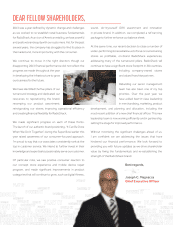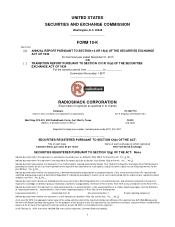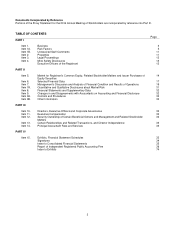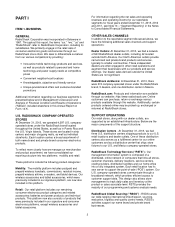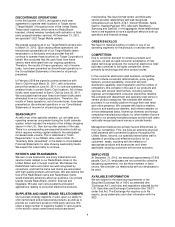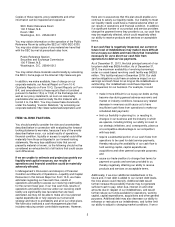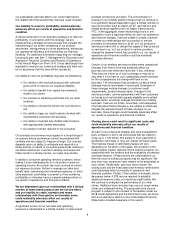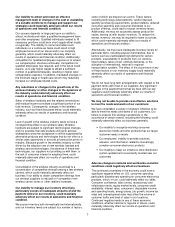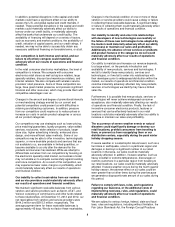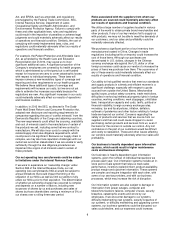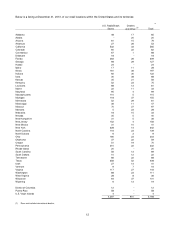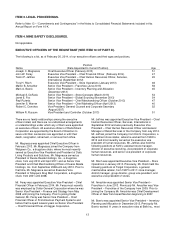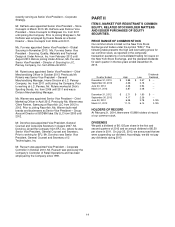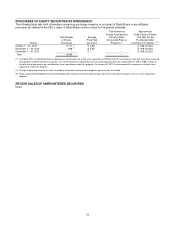Radio Shack 2013 Annual Report Download - page 8
Download and view the complete annual report
Please find page 8 of the 2013 Radio Shack annual report below. You can navigate through the pages in the report by either clicking on the pages listed below, or by using the keyword search tool below to find specific information within the annual report.6
our subsidiaries add new debt to our current debt levels,
the related risks that we and they now face could increase.
Our inability to return to profitability would materially
adversely affect our results of operations and financial
condition.
A critical component of our business strategy is to return to
profitability. In connection with this strategy, we are
implementing a strategic turnaround plan that includes the
repositioning of our brand, revamping of our product
assortment, reinvigorating our store experience, enhancing
our operational efficiency and maintaining our financial
flexibility. For additional information regarding our strategic
turnaround plan, see Item 7. Management’s Discussion and
Analysis of Financial Condition and Results of Operations
in this Annual Report on Form 10-K. It may take longer than
expected to execute our turnaround strategy and there can
be no assurance that this plan will be successful.
Our ability to return to profitability may also be affected by:
• Our ability to offer and sell products with sufficient
gross profit to improve our overall profitability
• Our ability to benefit from capital improvements
made to our stores
• Our success in attracting customers into our retail
locations
• Our ability to choose the correct mix of products to
sell
• Our ability to keep our retail locations stocked with
merchandise customers will purchase
• Our ability to maintain fully-staffed retail locations
with appropriately trained employees
• Our ability to remain relevant to the consumer
Our products and services must appeal to a broad range of
consumers whose preferences cannot be predicted with
certainty and are subject to frequent change. Our success
depends upon our ability to anticipate and respond in a
timely manner to trends in consumer preferences relating to
consumer electronics. If we fail to identify and respond to
these trends in a timely manner, our sales may decline.
In addition, consumer spending remains uncertain, which
makes it more challenging for us to maintain or grow our
operating income. As a result, we must continue to control
our expense structure. Failure to manage our labor and
benefit rates, advertising and marketing expenses, or other
store expenses could delay or prevent us from achieving
profitability or otherwise have a material adverse effect on
our results of operations and financial condition.
We are dependent upon our relationships with a limited
number of name brand product and service providers,
and our inability to create, maintain and renew
relationships with these parties on favorable terms
could materially adversely affect our results of
operations and financial condition.
A significant portion of our net sales and operating
revenues is attributable to a limited number of name brand
products and service providers. The concentration of
revenue in our mobility platform means that our revenue is
to a significant degree dependent upon a limited number of
service providers such as Sprint, AT&T, and Verizon and
related product suppliers such as Apple, Samsung and
HTC. In the aggregate, these relationships have or are
expected to have a significant effect on both our operations
and financial strategy. If we are unable to create, maintain
or renew our relationships with our product or service
providers on favorable terms or at all, or if our product or
service providers limit or disrupt the supply of their products
or services to us, or if our product or service providers
change the payment terms they provide to us, our results of
operations and financial condition could be materially
adversely affected.
Certain of our wireless service providers make operational
changes from time to time that adversely affect our
business and over which we have little, if any, influence.
They may not inform us of such a change or may do so
only after it is too late for us to adequately predict and plan
for the consequences the change will have on our
business. The information they provide to us about these
changes may be incomplete or inaccurate. Examples of
these changes include changes to customer credit
requirements, product release dates, changes to the
service providers’ service agreements with their customers
on issues such as handset upgrade eligibility and contract
renewal terms, and other changes that affect our mobility
business. If we are not timely, accurately, and adequately
informed about these changes or are unable to effectively
mitigate the adverse impact of these changes on our
business, these changes could materially adversely affect
our results of operations and financial condition.
Closing stores could result in significant costs and
could materially adversely affect our results of
operations and financial condition.
As part of our turnaround strategy and cash management
plan, on March 4, 2014, we announced that we intend to
close up to 1,100 stores. We expect to incur payments to
landlords to terminate or “buy out” leases for these stores.
The financial impact of terminating leases will vary
depending on the terms of the lease, the condition of the
local property market, demand for the specific property, our
relationship with the landlord and the availability of potential
sub-lease tenants. If these factors are unfavorable to us,
then the costs of exiting a property may be significant. We
also may incur severance costs related to the employees at
such stores. Additionally, upon any store closure, the
closing costs and the fixed asset and inventory write downs
could adversely affect our results of operations and
financial condition. Finally, if the number of domestic stores
decreases below 4,278, we are required to establish
additional reserves under our revolving credit facility. We
will continue to evaluate the performance of our other
stores. Additional store closures may occur in cases where
stores are underperforming. The proposed store closure
program is subject to the consent of the lenders under our
2018 Credit Agreement and the 2018 Term Loan (as those
terms are defined in Note 5 to the Consolidated Financial
Statements included elsewhere in this report).


